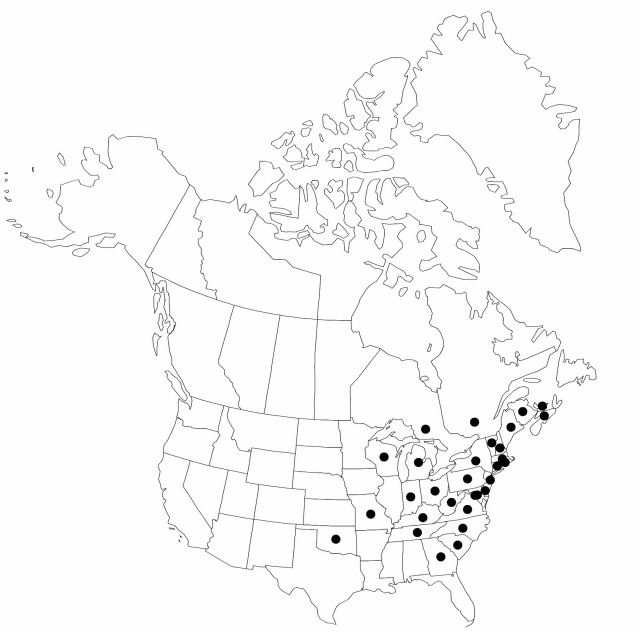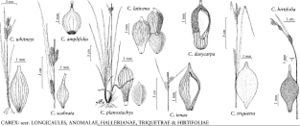Carex scabrata
Ann. Lyceum Nat. Hist. New York 1: 69. 1824.
Culms brownish at base, 30–90 cm. Leaves: sheaths glabrous; ligules 11–43(–53) mm; blades dark green, 10–40 cm × 4–8(–12) mm, those of prominent sterile shoots to 18 mm wide, prominently scabrous on adaxial surface. Spikes: 4–7(–9), oblong to short-cylindric; proximal spikes long-peduncled (occasionally branched), the distal progressively less so or subsessile; pistillate spikes closely 10–160-flowered (70–230-flowered if branched), 1–5.5(–7) cm × 5.5–8(–9) mm; staminate spike 1.5–5 cm. Pistillate scales nearly equaling bodies of perigynia, apex acute, acuminate, or short-awned, ciliolate. Perigynia olive-green, 2-ribbed, strongly 6–8-veined, obovoid, 3.4–4.5 mm, minutely scabrous-puberulent; beak 1.3–1.9 mm, orifice obscurely bidentate. Achenes obovoid, 1.8–2.3 × 1.2–1.5 mm. 2n = 54.
Phenology: Fruiting Jun (mid May in South)–early Sep.
Habitat: Wet woods, springy thickets, especially seepage slopes, creek borders, ravine bottoms, or other wet spots in rich deciduous woods, less often in wet clearings and swamps, in calcareous, circumneutral, or acidic soils
Elevation: 20–2000 m
Distribution

N.B., N.S., Ont., P.E.I., Que., Conn., Del., D.C., Ga., Ind., Ky., Maine, Md., Mass., Mich., Mo., N.H., N.J., N.Y., N.C., Ohio, Okla., Pa., R.I., S.C., Tenn., Vt., Va., W.Va., Wis.
Discussion
Carex scabrata is most common in the upland portions of its range, extending southward in the Appalachian system and reappearing westward (known from one historic collection each) in the Ozarks and Ouachitas.
There are reports for the supposed hybrid Carex crinita Lamarck × C. scabrata, described by M. L. Fernald (1895) and subsequently mentioned in lists of New England plants and by B. L. Robinson and M. L. Fernald (1908) and M. L. Fernald (1950). Fernald (1950) also listed a second hybrid of very similar parentage and equally doubtful status, C. gynandra Schweinitz × C. scabrata. Four specimens (in GH) supposedly representing both parental combinations are all C. gynandra (fide L. A. Standley, pers. comm).
Selected References
None.
